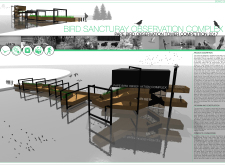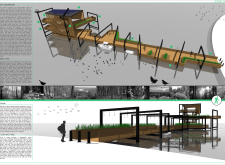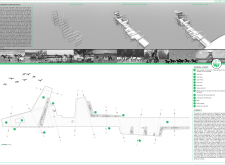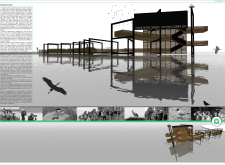5 key facts about this project
At its core, the project functions as a multi-use space that accommodates various activities, reflecting the needs of the community it serves. The design emphasizes flexibility, allowing for distinct yet interconnected spaces that cater to different user requirements. This adaptability is a key element, ensuring that the project remains relevant and useful over time.
The exterior of the building showcases a modern architectural language, characterized by clean lines and carefully chosen materials that resonate with the local environment. Large windows facilitate natural light, fostering a sense of openness while blurring the boundaries between the interior and exterior. The thoughtful arrangement of these openings not only enhances energy efficiency but also creates a dynamic play of light and shadow throughout the day.
A striking feature of this project is its sustainable design strategies, which prioritize environmental responsibility without compromising on aesthetics. The use of locally sourced materials underscores a commitment to reducing the carbon footprint associated with transportation. Green roofs and integrated landscaping contribute to biodiversity, while also managing stormwater effectively. This design approach reflects a growing awareness within architecture to harmonize building practices with ecological considerations.
Internally, the layout is designed to promote community engagement, featuring communal areas that encourage interaction among users. These spaces are characterized by their inviting ambiance, fostering a sense of belonging and facilitating social connections. The thoughtful integration of technology enhances the user experience, with smart systems that allow for efficient energy management, contributing to the overall sustainability of the project.
Unique design approaches are evident throughout the project. A modular construction methodology has been employed, allowing for efficient building processes while maintaining high standards of quality and design integrity. This approach not only reduces waste but also allows for flexibility in future expansions or modifications, ensuring the building can evolve alongside the community it serves.
The project brings to the forefront the importance of context in architectural design. By considering local cultural references and environmental conditions, the architects have created a building that does not merely occupy space but enriches the landscape, contributing to the identity of the locale. The careful selection of materials further reflects this sensitivity, with textures and finishes that resonate with the traditional architecture of the area while introducing a contemporary twist.
In conclusion, this architectural project exemplifies a holistic approach to design, where function, sustainability, and community are intricately woven together. The careful attention to detail in every aspect of the project reveals a deep understanding of the principles of good architecture. Readers are encouraged to explore the project presentation for further insights into its architectural plans, sections, and innovative design ideas to appreciate the full breadth of its impact and significance.


























